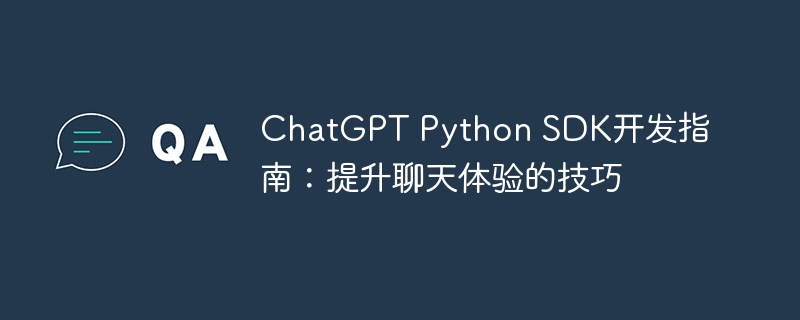

ChatGPT Python SDK Development Guide: Tips to improve the chat experience, specific code examples are required
Introduction:
ChatGPT is a powerful chat engine developed by OpenAI , through machine learning technology, able to communicate naturally with users. ChatGPT has broad application prospects in social robots, virtual assistants and other applications. This article will introduce how to use the ChatGPT Python SDK to develop chatbots, and provide some tips and specific code examples to improve the chat experience.
1. Installation and setup
First, you need to install ChatGPT Python SDK. It can be installed using the pip command.
pip install openai
Before using ChatGPT, you need to obtain OpenAI’s API key. You can register and obtain an API key on OpenAI's official website. Once you have obtained the key, you can set it as an environment variable or use it directly in your code.
import openai openai.api_key = ' your-api-key '
2. Basic functions
Using ChatGPT Python SDK, you can send a chat request containing user input and get ChatGPT's answer. The code example is as follows:
response = openai.Completion.create( engine="text-davinci-003", prompt="你好,我是ChatGPT。请问有什么我可以帮助您的吗?", max_tokens=100, n=1, stop=None, temperature=0.7 ) answer = response.choices[0].text.strip() print(answer)
When sending a chat request, you can control the generated responses by setting parameters. The following are some commonly used parameters:
3. Tips to improve the chat experience
In multi-round conversations, maintaining context is very important. The user's historical inputs can be stored in a list and passed to ChatGPT every time a chat request is sent. For example:
history = []
while True:
user_input = input("User: ")
history.append(user_input)
response = openai.Completion.create(
engine="text-davinci-003",
prompt="
".join(history),
max_tokens=100,
n=1,
stop=None,
temperature=0.7
)
answer = response.choices[0].text.strip()
print("ChatGPT: " + answer)
history.append(answer)ChatGPT’s answers may contain inappropriate or inappropriate content. In order to provide a better chat experience, you can use filtering The answer is filtered.
import openai
from openai import Filter
openai.api_key = 'your-api-key'
openai.Filters.set_model('davinci')
response = openai.Completion.create(
prompt="你好,我是ChatGPT。请问有什么我可以帮助您的吗?",
max_tokens=100,
n=1,
stop=None,
temperature=0.7,
filter=Filter('content')
)
answer = response.choices[0].text.strip()
print(answer)4. Summary
This article introduces how to use ChatGPT Python SDK to develop chatbots, and provides some tips and specific code examples to improve the chat experience. By properly setting parameters, maintaining context, and filtering inappropriate content, ChatGPT can be made more intelligent and expected in communication. I hope this article will help you develop a ChatGPT robot!
(Total word count: 840)
The above is the detailed content of ChatGPT Python SDK Development Guide: Tips to Improve Chat Experience. For more information, please follow other related articles on the PHP Chinese website!
 What are the Chinese programming languages?
What are the Chinese programming languages?
 Java-based audio processing methods and practices
Java-based audio processing methods and practices
 How to display html in the center
How to display html in the center
 What are the microcontroller programming software?
What are the microcontroller programming software?
 How to get the input number in java
How to get the input number in java
 How to delete a file in linux
How to delete a file in linux
 Python thread pool and its principles and uses
Python thread pool and its principles and uses
 Solution to the problem that win7 system cannot start
Solution to the problem that win7 system cannot start
 js method to get array length
js method to get array length




